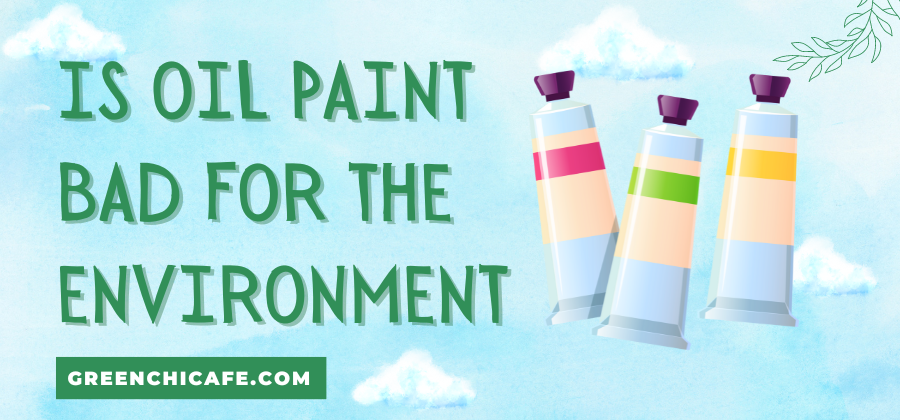Oil paints contain chemicals that can harm humans and the environment, but is oil paint bad for the environment?
While oil paints pose some risks, following safety precautions minimizes negative impacts.
This article examines the potential risks and how to use them responsibly.
Is Oil Paint Bad for the Environment?

Based on the research, oil paint does have some negative environmental impacts that need to be properly managed.
However, it is less hazardous than many other art mediums and industrial applications if handled correctly.
With informed safety practices, the overall risks of oil paint remain relatively small.
Key Points
- Oil paints themselves contain minimal VOCs but require toxic solvents.
- Proper ventilation is critical when using oil paints.
- Heavy metal pigments like cadmium pose health risks.
- Allowing rags to dry flat prevents fires.
- Dispose of paints and solvents according to hazardous waste guidelines.
How Do Oil Paints Impact Indoor Air Quality?
Exposure to oil paint fumes can cause headaches, eye irritation, and other symptoms.
Oil paints contain volatile organic compounds (VOCs) that evaporate into the air as the paint dries.
The solvents and mediums used with oil paints also contain VOCs.
However, oil paints emit lower quantities of VOCs compared to materials like acrylics.
Properly ventilated rooms and safe handling minimize potential VOCs from oil paints.
Working outdoors or wearing a respirator also reduces risk.
Overall, oil paints pose less of an air pollution threat than many common art supplies if used correctly.
Do Oil Paints Themselves Contain Toxic Chemicals?
Oil paints are made from natural pigments suspended in drying oils like linseed or safflower oil.
In general, oil paints themselves do not contain toxic chemicals or release VOCs as they cure.
Unlike acrylics, the pigments and binders in oil paints are relatively safe.
However, some colors contain heavy metals like cadmium or cobalt.
Cadmium produces brilliant yellows and oranges but is highly toxic.
Many cadmium paints are now cadmium-free, using safer hues.
Overall, oil paint pigments are less toxic than other art media like acrylics or spray paints.
How Do Solvents and Paint Thinners Affect the Environment?
While the paint itself may not be toxic, the thinners and solvents commonly used in oil painting can be harmful.
Paint thinners like turpentine and mineral spirits give off VOCs and flammable fumes.
They can release hazardous air pollutants when not handled correctly.
Proper disposal of solvents is crucial to avoiding groundwater contamination.
Letting them evaporate releases VOCs into the atmosphere.
Instead, blends low in VOCs are safer options for thinning and cleaning up oil paints.
Does Improper Disposal of Oil Paint Pose Risks?
Like other paints, oil-based paint should not be poured down the drain or disposed of in regular trash.
The pigments and chemicals can leach into soil and groundwater, leading to environmental harm.
Oil paints should be fully dried out and then disposed of according to hazardous waste guidelines.
Letting paint dry on rags can lead to combustion.
Rags should be laid flat to dry in an open, ventilated area away from combustibles.
Properly disposing of leftover paints and materials prevents pollution risks.
Is Oil Paint a More Sustainable Art Medium?
Oil paint’s longevity makes it more sustainable than disposable acrylics.
With proper care, an oil painting can last for centuries without fading or yellowing.
Oil paint is also derived from renewable plant-based oils, unlike plastic-based paints.
However, oil paint production requires solvent extraction.
Linseed and safflower oils must be mechanically pressed and treated with hexane solvents.
The pigments also undergo industrial mining and processing.
Overall, oil paint is not sustainably produced, but has advantages over acrylics in longevity.
How Does Recycled Oil Paint Compare?
Many companies now reclaim leftover oil paints to reduce waste.
Gamblin Artists Colors takes unused paint and reforms it into usable colors.
However, recycled paint contains lower pigment levels, producing weaker tints.
The sources of reclaimed paint may also vary.
Overall, recycled oil paint provides environmental benefits by keeping paint out of the waste stream.
However, the pigment extraction process still carries environmental costs.
Recycled oil paint works for underpainting and backgrounds, but provides lower quality than fresh paint.
What Precautions Help Minimize Impacts of Oil Paints?
Here are tips for safely using oil paints:
- Work in well-ventilated spaces with airflow to minimize VOCs.
- Choose cadmium-free hues and low-VOC thinners and solvents.
- Allow rags to fully dry flat before disposal to prevent fires.
- Dispose of paints properly rather than washing them down the drain.
- Use minimal solvents and clean brushes with plant-based soaps when possible.
- Opt for recycled paints for less critical backgrounds and drafting.
- Wear gloves and wash skin after use as pigments can absorb into the body.
Are There Non-Toxic Oil Paint Alternatives?
For artists hoping to avoid solvents entirely, water-soluble oil paints offer a greener choice.
These special oil paints thin and clean up with water instead of chemicals.
Brands like Holbein Artists’ Oil Colors offer water-mixable options.
Plant-based oils like walnut oil can also substitute traditional thinners.
And many natural plant and clay pigments are less toxic than modern hues.
While not completely hazard-free, these options reduce the exposure to VOCs and toxic pigments in standard oil painting.
Is Oil Paint a Significant Pollutant Compared to Other Art Forms?
Oil painting is likely less detrimental than industrial painting applications or artistic methods like spray paint.
The pigments themselves have low inherent toxicity compared to other media.
With proper handling, the overall impact of oil painting on the environment remains relatively minor.
Far more VOCs come from the billions of cans of solvent-based spray paints than the relatively small fine arts market.
And architectural acrylic lacquers used in construction contain harsher ingredients than artists’ oil paints.
Practicing safety and moderation helps limit risks.
How does oil paint affect indoor air quality?
Oil paints contain volatile organic compounds (VOCs) that evaporate as the paint dries and can reduce indoor air quality.
The solvents and thinners used with oil paint also contribute to VOCs when painting indoors without proper ventilation.
The VOC levels released can vary depending on the specific type and brand of paint.
Exposure to VOCs from oil paint fumes can potentially cause eye, nose, and throat irritation, headaches, dizziness, and other symptoms in some individuals.
Proper ventilation is critical when using oil paints indoors.
Working in rooms with open windows, fans, or air filtration systems helps circulate fumes and improve air quality.
Choosing low-VOC oil paints and solvents can also minimize air impacts.
Wearing a protective respirator masks exposure to paint fumes.
Overall, oil paints reduce indoor air quality less than many other art mediums, especially spray paints or acrylic lacquers.
But adequate ventilation and safe handling practices remain important.
Is oil paint toxic to humans?
Oil paints contain pigments, binders, and solvents that can potentially pose health hazards if used unsafely.
Some pigments, such as cadmium or cobalt, are highly toxic.
Long-term exposure to cadmium can potentially cause lung cancer and kidney damage.
Other heavy metal pigments are also dangerous if ingested or inhaled.
Many modern hues use less toxic synthetic pigments, but risks remain with certain colors.
The petroleum-based solvents and thinners used in oil painting can also have toxic effects.
Inhaling paint fumes or absorbing solvents through the skin carries hazards.
Certain solvents like turpentine can irritate eyes, skin, and mucous membranes.
Drinking or inhaling paint thinner can poison the body.
However, oil paints are considered less acutely toxic than many other art supplies if handled carefully.
The pigments do not vaporize like spray paint, for example.
Artists should wear gloves when handling paints, work in ventilated areas, and avoid ingesting any art materials to limit potential oil paint risks.
While not completely benign, oil paint toxicity can be minimized with prudence.
How do oil paint fumes affect pets?
The fumes from oil paints and thinners can potentially cause harm to pets, especially birds and small mammals prone to respiratory issues.
Dogs and cats may experience eye, skin, or lung irritation from paint fumes.
Solvent exposure can cause chemical pneumonia, nausea, or dizziness in pets if ingested.
Cats are especially sensitive due to their grooming habits, as they may lick off and ingest toxic pigments from their coats.
Dogs may inhale or absorb solvents from surfaces or rags.
Birds also have very sensitive respiratory systems that paint fumes can easily damage.
Keeping pets away from the painting area reduces risks.
Providing good ventilation, safely storing materials, and avoiding exposure to wet paints and thinners helps limit oil painting risks for pets.
Monitoring for signs of discomfort or illness after exposure to fumes provides early detection.
Overall, common-sense precautions allow artists to paint safely at home with pets with minimal health impacts.
Why is cadmium dangerous in oil paints?
Cadmium produces brilliant yellows, oranges, and reds but is also highly toxic.
Metal is a known carcinogen that can cause severe kidney, lung, and liver damage.
Cadmium pigments are water-soluble, meaning they can leach into the environment when washed down the drain.
Artists should avoid licking brushes or ingesting any paint with cadmium.
Even breathing in cadmium dust when sanding or spraying paint carries risk.
Many companies now offer cadmium-free hues using synthetic iron oxide pigments.
With safe handling, cadmium oil paints pose minimal exposure risks.
But ingestion or long-term inhalation of cadmium dust carries significant dangers, making it one of the most hazardous artist pigments.
How should oil paints be disposed of?
To avoid harming the environment, leftover oil paint should not be washed down the drain or placed in regular trash.
Oil paint has the potential to leach into groundwater, soil, or aquatic ecosystems when not disposed of properly.
Even dried-out paint contains pigments and substances that persist as pollutants.
Instead, unused oil paint should be fully hardened and then disposed of according to hazardous waste regulations in your region.
Some art supply stores also accept old paints for recycling.
Rags used to apply oil paint should dry flat in a ventilated area before disposal to avoid combustion.
Proper oil paint disposal reduces risks of groundwater contamination, pollution, and accidental fires in waste management facilities.
Conclusion
Oil paints demand safety precautions due to solvents and pigments that can impact health and the environment.
However, they pose less overall risk than many artistic and industrial applications.
Following best practices for ventilation, disposal, and sustainability minimizes the hazards of oil painting.
With proper handling, oil paint remains a versatile, enduring medium.
The main takeaways are using low-VOC solvents and thinners, ventilating properly when painting, disposing of materials safely, and limiting exposure to pigment.
Awareness of risks allows artists to take steps to mitigate harm from painting.
Overall, oil paint can be used responsibly to create timeless works without substantial environmental damage.
Frequently Asked Questions
What type of oil paint is most eco-friendly?
Water-soluble oil paints are the most eco-friendly, as they clean up with water instead of chemical thinners and solvents. This helps reduce exposure to VOCs.
How should I dispose of leftover oil paint?
Allow any leftover oil paint to completely dry out, then dispose of it according to hazardous waste regulations in your area. Never pour wet paint down the drain.
Which oil paint pigments are non-toxic?
Many modern hues made from synthetic organic compounds are less toxic than older pigments based on heavy metals. Cadmium, cobalt, and lead oil paints contain toxins.
Does oil paint fumes cause health issues?
Exposure to oil paint fumes can potentially cause eye, nose, and throat irritation, headaches, dizziness, and other symptoms. Proper ventilation minimizes this risk.
Are there any oil paint recycling programs?
Some art supply companies like Gamblin Artists Colors operate reuse programs, taking leftover paints and reformulating them into usable colors.
The team at GreenChiCafe cares deeply about the environment and strives to provide content that informs people and helps them live sustainably. Check out our website for more articles on green living and preserving our planet’s precious natural resources.

Annie is a passionate environmental writer and activist. She has been writing about sustainability, conservation, and green living for over 15+ years. Annie is dedicated to raising awareness about environmental issues and providing practical tips for living an eco-friendly lifestyle. When she’s not writing, you can find her volunteering with local environmental organizations, teaching workshops on zero waste living, or exploring nature. Feel free to get in touch with Annie: annie@greenchicafe.com

